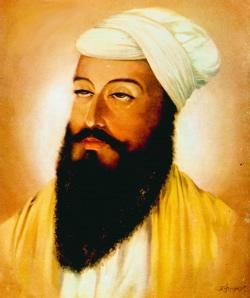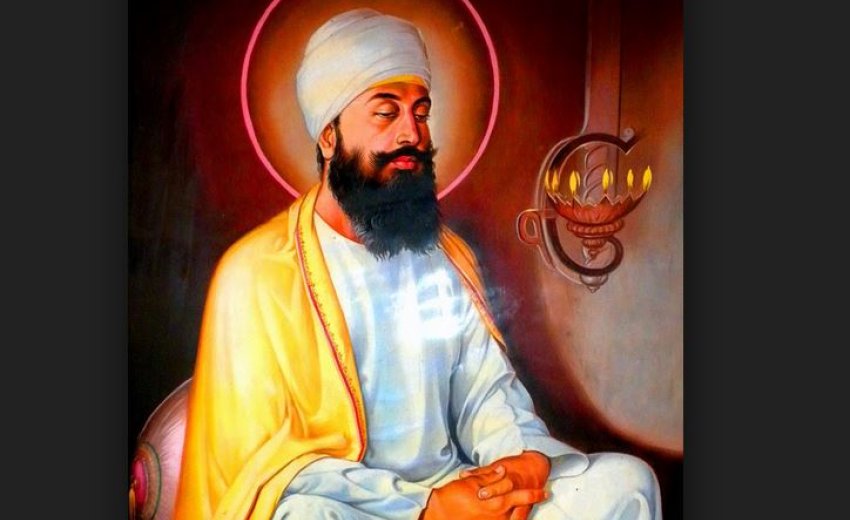Sacrifice means surrendering or giving up something valuable for the sake of another thing considered more important. We therefore have the mother forgoing her comforts for the sake of her baby or one friend giving up his interest for the other. Parents tighten their hands on expenditure to provide for their children's education and so on. All faiths have examples of such sacrifices in their history. Rama of the Ramayana was exiled in order to uphold his father's word to Rama's step mother. The Old Testament shows that Abraham was about to sacrifice his son Isaac at God's bidding but he was saved by Divine action.
Self sacrifice, i.e., giving one’s life tops all other sacrifices and is appropriately called ‘supreme sacrifice'. This sacrifice has been offered by people in independence movements and also for standing up against religious persecution. Generally speaking it refers to a person maintaining his (or her) religious affiliations and not succumbing to pressures to compromise on those. He thus offers the supreme sacrifice for what he holds dear:
ਜਿਸੁ ਪਿਆਰੇ ਸਿਉ ਨੇਹੁ ਤਿਸੁ ਆਗੈ ਮਰਿ ਚਲੀਐ ॥
ਧ੍ਰਿਗੁ ਜੀਵਣੁ ਸੰਸਾਰਿ ਤਾ ਕੈ ਪਾਛੈ ਜੀਵਣਾ ॥੨॥ ੨ ੮੩
We should be prepared to die for what we hold dear: it is a curse to live without it (M: 2, SGGS, p 83).
One who is prepared to make the supreme sacrifice to safeguard the interests of the helpless is really brave:
ਸੂਰਾ ਸੋ ਪਹਿਚਾਨੀਐ ਜੁ ਲਰੈ ਦੀਨ ਕੇ ਹੇਤ ॥
ਪੁਰਜਾ ਪੁਰਜਾ ਕਟਿ ਮਰੈ ਕਬਹੂ ਨ ਛਾਡੈ ਖੇਤੁ ॥੨॥੨॥ ਕ ੧੧੦੫
A real warrior is one who fights for the helpless. He may be cut into pieces but will not abandon the cause (Kabir, SGGS, p 1105).
With this in mind let us discuss two oft-mentioned sacrifices, those of Jesus of Nazarath and of Shri Guru Tegh Bahadur, the ninth Sikh Guru. We shall study the circumstances leading to these two sacrifices and the events immediately thereafter.
Jesus (2 BCE – 33CE) was born a Jew and died as one. The New Testament covers the period of his life and shortly after wards. It contains four gospels. Two of them (by Matthew and Luke) give two different accounts of his birth from a virgin mother. The other two (by Mark and John) do not support the concept of Jesus' virgin birth. The Bible does not give any account of his activities after birth until he is thirty years old and is baptised. It then shows Jesus performing miracles and acting as an exorcist. He also taught at the synagogue (Jewish temple). He found the practices there unacceptable and criticized the religious leaders. He criticized corruption and stopped it, e.g., with the presence of the money changers at the temple.
Guru Tegh Bahadur (April 1621 – Nov 1675 CE) was the ninth Guru of the Sikhs. He was the son of the sixth Guru but was bypassed to be the seventh. Sikh religion had been growing in a very hostile environment with most of the Mughal rulers of India showing little tolerance for other religions. His grandfather Guru Arjun had been tortured to death and his father Guru Hargobind imprisoned. But the Guru never got intimidated and continued with his religious work.
He established a base for the faith at Anandpur Sahib meaning the 'City of Bliss', in the province of Punjab, India.The then Mughal Emperor Aurangzeb had let loose a reign of terror particularly in Kashmir in order to force the Brahmins there to convert to Islam. Towards the end of 1675 CE a group of these Brahmins came to Guru Tegh Bahadur and related their persecution. The Guru, realizing that the rulers had to be confronted, asked the Brahmins to tell the rulers that if the Guru was converted they would follow suit. They did that and the Guru was asked by the rulers to come to Delhi, the Indian capital. After a few days he went there.
The Jewish priests were furious with Jesus because of his activities and utterances. He had also described himself as the son of God. This was not acceptable to the Jews and they wanted to get him. He was not caught on some occasions due to fear of backlash from his followers while on some others he successfully evaded being caught. When it became clear to Jesus that he would be arrested he told his disciples of this. After that he went up a mountain to pray along with his disciples. While he prayed the disciples went to sleep. The Bible says:
And he cometh unto the disciples, and findeth them asleep, and saith unto Peter, What, could ye not watch with me one hour"? (Matthew 26:40).
(This and all quotations that follow are from King James Version of the Bible. In the above reference 1:4 means Chapter 1, verse 4. SGGS in the Gurbani reference stands for Sri Guru Granth Sahib, the Sikh scripture).
When his arrest seemed imminent Jesus was frightened and told his disciples:
My soul is exceeding sorrowful, even unto death: tarry ye here, and watch with me (Matthew 26:38).
He also prayed to God to spare him if possible but also said that God's will shall prevail:
And he went a little further, and fell on his face, and prayed, saying, O my Father, if it be possible, let this cup pass from me: nevertheless not as I will, but as thou wilt (Mathew 26:39).
All his disciples forsook him and fled (Matthew 26:56).
Guru Tegh Bahadur was accompanied by a number of his disciples to Delhi where they were arrested along with him. They were asked to convert to Islam but they refused. In order to frighten the Guru and the disciples, the latter were subjected to severe torture. First Bhai Mati Das was sawed into two. Oil-soaked cloth was wrapped round Bhai Sati Das and set on fire. Bhai Dayal Das was put in a cauldron of boiling water. They gave their lives remaining firm in their resolve.
After the Jewish priests were finally able to get Jesus arrested, he was presented to the Governor, Pontius Pilate. After inquiry the Governor was hesitant to punish Jesus but they told the Governor:
“We have a law, and by our law he ought to die, because he made himself the Son of God” (John 19:7).
 Jesus was sentenced to death. There are two different accounts of his execution. One says that he was crucified on the cross (Matthew 27:35) while according to the other he was hanged on a tree (Acts 5:30).
Jesus was sentenced to death. There are two different accounts of his execution. One says that he was crucified on the cross (Matthew 27:35) while according to the other he was hanged on a tree (Acts 5:30).
There are thus varying accounts each of Jesus’ birth and death.
The Bible says that while on the cross and before he breathed his last he said:
My God, my God, why hast thou forsaken me? (Matthew 27:46).
That shows that Jesus was first forsaken by his disciples and then by God before he died.
The Bible states that Jesus gave his life for the sins of all:
Who gave himself for our sins, (Galatians 1:4).
Guru Tegh Bahadur was made to see all the torture on his disciples to try to lower his morale but he never gave up courage. He was asked to either convert to Islam or to show a miracle to escape death. He refused to do either, even after persuasions and offers of temptations. He was then beheaded. Guru Tegh Bahadur gave his life for defending the rights of Kashmir Brahmins to practice their religion which was not his own religion:
ਤਿਲਕ ਜੰਵੂ ਰਾਖਾ ਪ੍ਰਭ ਤਾ ਕਾ ॥ ਕੀਨੋ ਬਡੋ ਕਲੂ ਮਹਿ ਸਾਕਾ ॥
ਸਾਧਨ ਹੇਤਿ ਇਤੀ ਜਿਨਿ ਕਰੀ ॥ ਸੀਸੁ ਦੀਆ ਪਰ ਸੀ ਨ ਉਚਰੀ ॥੧੩॥
He created history of this age by protecting the religious symbols of the Brahmins; he gave his life without showing any sign of pain (Bachitar Natak, 13).
ਧਰਮ ਹੇਤਿ ਸਾਕਾ ਜਿਨਿ ਕੀਆ ॥ ਸੀਸੁ ਦੀਆ ਪਰ ਸਿਰਰੁ ਨ ਦੀਆ ॥
ਨਾਟਕ ਚੇਟਕ ਕੀਏ ਕੁਕਾਜਾ ॥ ਪ੍ਰਭ ਲੋਗਨ ਕਹ ਆਵਤ ਲਾਜਾ ॥੧੪॥
He created history for protecting (others') religion; he gave his life but did not show a miracle; Miracles are drama, and evil; men of God are ashamed even to talk of them (Bachitar Natak, 14).
Jesus had twelve nominated disciples but none of them came forward to claim his body. None of his family members i.e. his mother or brothers also came forward to claim it. A rich man Joseph of Arimathaea, described as a disciple, claimed the body and put it in a tomb in his garden.
The Bible does not mention any one, except one lady Mary Magdalene who was close to Jesus, showing any sorrow on his death.
 When Guru Tegh Bahadur was executed, the rulers challenged any one to claim his body. No one claimed it openly but a devoted Sikh Bhai Jaita collected the Guru’s head and stealthily took it to Anandpur Sahib to deliver to his son Guru Gobind Singh for cremation. Similarly another Sikh Bhai Lakhi Shah Vanjara carried the head-less body to his house in the dark of night and set his house on fire to cremate it. This was done so that the rulers did not come to know of it. Gurduara Rakab Ganj now stands at that site in New Delhi. Bachitar Natak says:
When Guru Tegh Bahadur was executed, the rulers challenged any one to claim his body. No one claimed it openly but a devoted Sikh Bhai Jaita collected the Guru’s head and stealthily took it to Anandpur Sahib to deliver to his son Guru Gobind Singh for cremation. Similarly another Sikh Bhai Lakhi Shah Vanjara carried the head-less body to his house in the dark of night and set his house on fire to cremate it. This was done so that the rulers did not come to know of it. Gurduara Rakab Ganj now stands at that site in New Delhi. Bachitar Natak says:
ਤੇਗ ਬਹਾਦਰ ਕੇ ਚਲਤ ਭਯੋ ਜਗਤ ਕੋ ਸੋਕ ॥ ਹੈ ਹੈ ਹੈ ਸਭ ਜਗ ਭਯੋ ਜੈ ਜੈ ਜੈ ਸੁਰ ਲੋਕਿ ॥੧੬॥
Guru Tegh Bahadur's departure was widely mourned;while the world was struck by sorrow he was glorified in God's presence (Bachitar Natak, 16).
The Bible describes Jesus' crucifixion as suffering:
For as the sufferings of Christ abound in us, so our consolation also aboundeth by Christ (2 Corinthians 1:5)
According to Guru Tegh Bahadur pleasure and pain make no difference to a man of God as they are part of life:
ਸੁਖੁ ਦੁਖੁ ਦੋਨੋ ਸਮ ਕਰਿ ਜਾਨੈ ਅਉਰੁ ਮਾਨੁ ਅਪਮਾਨਾ ॥
ਹਰਖ ਸੋਗ ਤੇ ਰਹੈ ਅਤੀਤਾ ਤਿਨਿ ਜਗਿ ਤਤੁ ਪਛਾਨਾ ॥੧॥੯ ੨੧੯
One who treats pain and comfort, honor and insult, equal; and is beyond pleasure or sorrow, knows the realities of life (M: 9, SGGS, 219).
Both the above sacrifices changed religious history.
Christianity came into being after Jesus' death and, if all its denominations are taken together, is today the largest religion worldwide. Jesus, despite his differences with the Jewish priests had not broken away from the faith. There were many amongst the Jews who had persecuted Jesus' followers. Paul, initially called Saul, was one of them. However he got converted after Jesus died and took upon himself to propagate what later came to be known as Christianity. The name Christian was used for the first time probably in 41 CE. He pushed the new faith mainly on grounds of crucifixion and resurrection of Jesus but never mentioned his virgin birth. He was helped by the apostle Peter. They were highly successful in their efforts.
Martyrdom of Guru Tegh Bahadur was a political act to suppress a religion. In fact it had started with the martyrdom of the fifth Guru after which the sixth Guru combined the spiritual and temporal aspects and the concept of Miri Piri was born. The tenth Guru made this permanent. Also no Sikh openly coming forward to claim Guru Tegh Bahadur's head and body was considered a serious matter and hence his son and the tenth Guru, Guru Gobind Singh resolved to give the Sikhs such a form and instill courage that they would never disown their identity. This came as the order of the Khalsa with their distinctive form of unshorn hair and a code of conduct that made them saint-soldiers. But for this the course of Indian political history would have been different, probably unipolar Islamic.
It would seem Guru Tegh Bahedur being bypassed to be sixth Guru was pre-ordained and he was destined to create history in receiving martyrdom for a religion that was not his. His was also the unique example of personally going to receive martyrdom.
By Rawel Singh
www.sadhsangat.com

